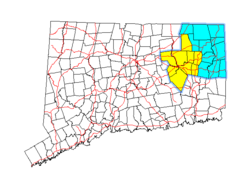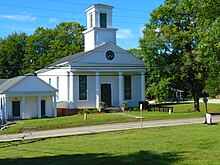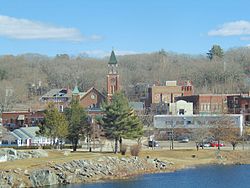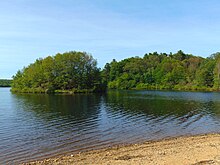
The Boston Post Road was a system of mail-delivery routes between New York City and Boston, Massachusetts, that evolved into one of the first major highways in the United States.
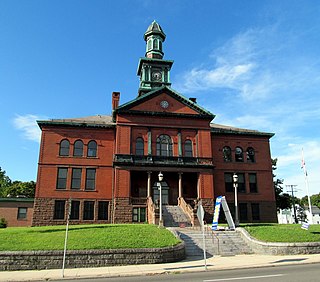
Windham County is one of the eight historical counties in the U.S. state of Connecticut, located in its northeastern corner. As of the 2020 census, the population was 116,418, making it the least populous county in Connecticut. It forms the core of the region known as the Quiet Corner. Windham County is included in the Worcester, MA-CT Metropolitan Statistical Area, which is also included in the Boston-Worcester-Providence, MA-RI-NH-CT Combined Statistical Area. The entire county is within the Quinebaug and Shetucket Rivers Valley National Heritage Corridor, as designated by the National Park Service.

Brooklyn is a town in Windham County, Connecticut, United States. The town is part of the Northeastern Connecticut Planning Region. The population was 8,450 at the 2020 census. The town center village is listed by the U.S. Census Bureau as a census-designated place. The district of East Brooklyn is listed as a separate census-designated place.
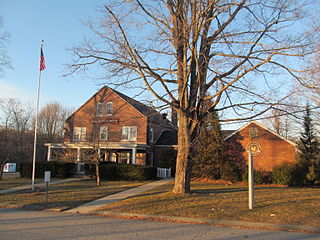
Pomfret is a town located in Windham County, Connecticut with a population of 4,266 according to the 2020 United States Census. The town is part of the Northeastern Connecticut Planning Region. The town was incorporated in 1713 and was named after Pontefract in West Yorkshire, England. The land on which Pomfret stands today was purchased from Native Americans in 1686 in a deal known as the "Mashmuket Purchase" or "Mashamoquet Purchase".

Putnam is a town in Windham County, Connecticut, United States. The town is part of the Northeastern Connecticut Planning Region. The population was 9,224 at the 2020 census.

Thompson is a town in Windham County, Connecticut, United States. The town is part of the Northeastern Connecticut Planning Region. The town was named after Sir Robert Thompson, an English landholder. The population was 9,189 at the 2020 census. Thompson is located in the northeastern corner of the state and is bordered on the north by Webster, Massachusetts and Dudley, Massachusetts, on the east by Douglas, Massachusetts and Burrillville, Rhode Island, on the west by Woodstock, Connecticut, and on the south by Putnam, Connecticut.
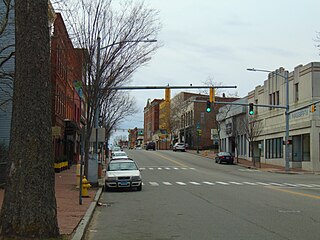
Willimantic is a census-designated place located in the town of Windham in Windham County, Connecticut, United States. It is a former city and borough, and is currently organized as one of two tax districts within the Town of Windham. Willimantic is part of the Southeastern Connecticut Planning Region. Known as "Thread City" for the American Thread Company's mills along the Willimantic River, it was a center of the textile industry in the 19th century. Originally incorporated as a city in 1893, it entered a period of decline after the Second World War, culminating in the mill's closure and the city's reabsorption into the town of Windham in the 1980s. Heroin use, present since the 1960s, became a major public health problem in the early 2000s, declining somewhat by the 2010s. Though the city was a major rail hub, an Interstate Highway has never passed within ten miles, despite early plans to connect it.

Woodstock is a town in Windham County, Connecticut, United States. The town is part of the Northeastern Connecticut Planning Region. The population was 8,221 at the 2020 census.

Connecticut's 2nd congressional district is a congressional district in the U.S. state of Connecticut. Located in the eastern part of the state, the district includes all of New London County, Tolland County, and Windham County, along with parts of Hartford, Middlesex, and New Haven counties. Principal cities include Enfield, Norwich, New London, and Groton.

Route 169 is a 47.36-mile-long (76.22 km) state highway in the U.S. states of Connecticut and Massachusetts. It begins in the city of Norwich, Connecticut, and runs 38 miles (61 km) through Northeastern Connecticut, continuing across the state line into Southbridge, Massachusetts. The route ends in Charlton after another nine miles (14 km). A portion of the route in the town center of Pomfret is on the National Register of Historic Places as Pomfret Street Historic District, and 32.10 miles (51.66 km) of the road is designated as the Connecticut State Route 169 National Scenic Byway.

Connecticut Route 14 is one of several secondary routes from eastern Connecticut into Rhode Island. It runs from the Willimantic section of the town of Windham to the Rhode Island state line in Sterling.

Air Line State Park Trail is a rail trail and linear state park located in Connecticut. The trail is divided into sections designated South, North a piece of the East Coast Greenway, and the Thompson addition. An additional 3.6-mile spur to Colchester is sometimes designated as part of the Air Line trail. At the Massachusetts state line, the trail connects to the Southern New England Trunkline Trail, a 22-mile-long trail to Franklin, MA built on the same right-of-way. Since 2018, the town of Portland, CT has also maintained a 2.3-mile portion of the Air Line trail, connecting to the southern end of the state park at the town line with East Hampton.
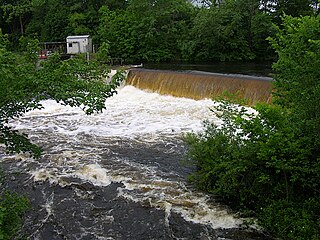
The Quinebaug River is a river in south-central Massachusetts and eastern Connecticut, with watershed extending into western Rhode Island. The name "Quinebaug" comes from the southern New England Native American term, spelled variously Qunnubbâgge, Quinibauge, etc., meaning "long pond", from qunni-, "long", and -paug, "pond". The river is one of the namesake rivers in the Quinebaug and Shetucket Rivers Valley National Heritage Corridor.

Route 244 is a secondary state highway in rural Northeastern Connecticut. It connects the towns of Eastford and Pomfret.

Route 171 is a state highway in northeastern Connecticut, running from Union to Putnam.
The Last Green Valley National Heritage Corridor is a federally designated National Heritage Corridor in northeastern Connecticut and portions of Massachusetts. It has a rural character with rolling hills, farmland and classic New England scenery. This area was designated because it is one of the last remaining stretches of green in the Boston to Washington, D.C. heavily urbanized corridor. The valley also has the largest stretch of dark night sky in the Northeast megalopolis corridor. It contains some of the largest unbroken forests in Southern New England, in a region of Connecticut known as the Quiet Corner.

The Southbridge and Blackstone Railroad was a railroad company that was the precursor to the Willimantic, Connecticut–Blackstone, Massachusetts line of the New York, New Haven and Hartford Railroad (NYNH&H). It was chartered in 1849 to build a line from Southbridge, Massachusetts, to Blackstone. In 1853, with construction underway, it was merged into the Boston and New York Central Railroad (B&NYC). The B&NYC used the charter of the East Thompson Railroad, another of its constituent lines, to alter the routing: west of East Thompson, Connecticut, the merged line continued southwest to Mechanicsville, Connecticut, where it met the Norwich and Worcester Railroad. The Mechanicsville–Blackstone line opened in 1854.
The Northeastern Connecticut Transit District (NECTD) is an agency providing multiple forms of public transportation in northeastern Connecticut. Six fixed routes (with deviation on request) provide week-round service to the towns of Brooklyn, Killingly, Plainfield, Putnam, and Thompson. Using fixed route service connections to WRTD can be made in Killingly and to SEAT in Plainfield respectively. With advance reservation NECTD also offers dial-a-ride service to the general public and door-to-door to select elderly and disabled persons. Dial-a-ride and door-to-door service is available to all towns served by NECTD's fixed routes as well as to Canterbury, Eastford, Hampton, Pomfret, Union, and Woodstock. Following a pilot program which began in 1977, NECTD was founded in October 1979, with its first service beginning in August 1980.

The Northeastern Connecticut Planning Region is a planning region and county-equivalent in Connecticut. It is served by the coterminous Northeastern Connecticut Council of Governments (NECCOG). In 2022, planning regions were approved to replace Connecticut's counties as county-equivalents for statistical purposes, with full implementation occurring by 2024.
